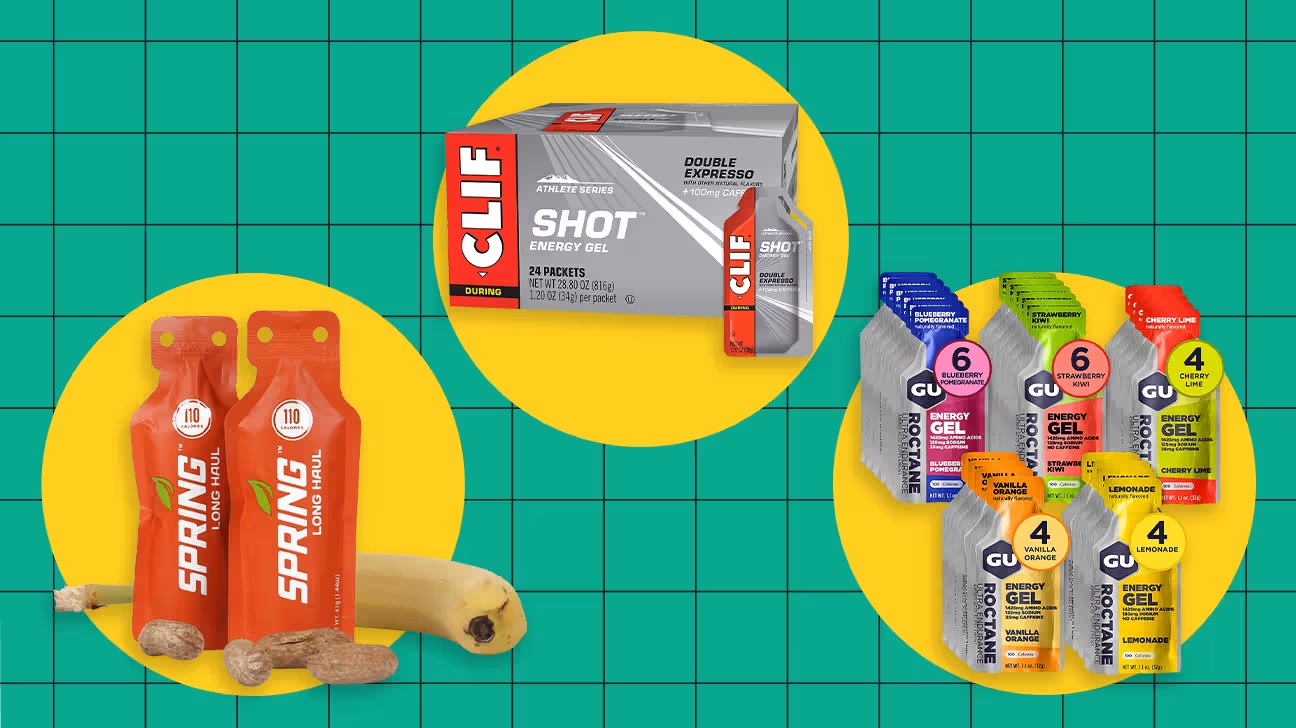

Featured
What Are Energy Gels Made Of
Modified: August 19, 2023
Discover what energy gels are made of and how they can enhance your performance. Learn about the featured ingredients that power these endurance-boosting supplements.
Introduction
Energy gels have become increasingly popular among athletes and fitness enthusiasts as a convenient and efficient way to fuel their performance during endurance activities. Whether you’re a runner, cyclist, or triathlete, energy gels can provide a quick source of energy to help you power through long workouts or races. These small, portable packets are designed to deliver a concentrated dose of carbohydrates, electrolytes, and other key nutrients, making them a staple for many athletes.
The primary goal of energy gels is to provide a readily available source of fuel that can be easily consumed during intense exercise. They are compact and easy to carry, making them practical for on-the-go consumption without the need for bulky food or complicated meal preparations. Energy gels are also formulated to be easily digestible, minimizing the risk of stomach discomfort or gastrointestinal issues that can arise during prolonged physical activity. With their convenience and effectiveness, energy gels have become an essential tool in the arsenal of athletes looking to optimize their performance.
Understanding the composition and contents of energy gels is crucial for athletes to make informed choices about which products to incorporate into their training and racing routines. In this article, we will delve into the various components found in energy gels, including carbohydrates, electrolytes, caffeine, and other ingredients commonly used to enhance their performance benefits.
So, if you’re curious about what exactly energy gels are made of and how they can help boost your performance, read on to discover the fascinating world behind these powerful fuel sources!
Purpose of Energy Gels
The purpose of energy gels is to provide a quick and concentrated source of energy for athletes engaging in endurance activities. When you’re pushing your body to its limits during long workouts or races, your glycogen stores can become depleted, leading to fatigue and a decline in performance. Energy gels help replenish these energy stores, allowing you to continue performing at your best.
Energy gels are specifically designed to be easily digestible and rapidly absorbed by the body. They typically contain a combination of fast-acting carbohydrates, electrolytes, and sometimes caffeine. These ingredients work together to provide an immediate source of fuel, rehydrate the body, and potentially enhance mental focus.
By consuming energy gels during exercise, athletes can maintain a steady supply of glucose to fuel their muscles and sustain their performance. The carbohydrates in energy gels are quickly broken down and converted into glucose, which is then transported to the muscles via the bloodstream. This replenishes the glycogen stores in the muscles, delaying the onset of fatigue and preserving endurance.
In addition to providing energy, energy gels also help to replenish electrolytes lost through sweat. Electrolytes such as sodium, potassium, and magnesium are essential for proper muscle function and hydration. By replacing these electrolytes during exercise, energy gels help to support optimal muscle performance and prevent cramping.
Furthermore, some energy gels may contain caffeine, a natural stimulant that can enhance alertness, focus, and reduce perceived exertion. Caffeine acts on the central nervous system, reducing the perception of fatigue and increasing endurance. However, it’s important to note that caffeine affects individuals differently, and it is essential to experiment with different products and dosages during training to determine what works best for you.
Overall, the purpose of energy gels is to provide a portable and easily digestible source of fuel that can sustain energy levels, prevent muscle fatigue, replenish electrolytes, and potentially enhance focus and endurance. Incorporating energy gels into your training and racing strategy can help improve your performance and keep you going strong during those grueling endurance activities.
Composition of Energy Gels
Energy gels are made up of various ingredients carefully selected to provide quick and sustained energy during physical activity. While the specific composition may vary between brands and flavors, the core components found in energy gels are carbohydrates, electrolytes, and sometimes caffeine.
Carbohydrates: Carbohydrates are the primary source of energy for our bodies, especially during exercise. Energy gels typically contain a mix of simple and complex carbohydrates, such as glucose, maltodextrin, fructose, and sucrose. These carbohydrates are rapidly broken down and converted into glucose, providing a readily available source of fuel for your muscles. The type and ratio of carbohydrates in energy gels are carefully formulated to ensure effective energy release and minimize gastrointestinal discomfort during prolonged activity.
Electrolytes: Electrolytes are minerals that help maintain fluid balance and proper muscle function. Common electrolytes found in energy gels include sodium, potassium, and magnesium. These electrolytes are essential for hydration, nerve function, and muscle contractions. During intense exercise, electrolytes are lost through sweat, and consuming energy gels can help replenish these crucial minerals, preventing dehydration and maintaining optimal performance.
Caffeine: Some energy gels may contain caffeine, a natural stimulant that can enhance mental alertness and reduce perceived exertion. The presence of caffeine in energy gels can boost endurance, enhance focus, and delay fatigue. However, it’s important to note that caffeine affects individuals differently, and its consumption should be tailored to personal tolerance and preferences.
Furthermore, energy gels may also contain other ingredients to enhance taste, texture, and shelf life. These may include natural or artificial flavors, preservatives, and thickening agents. It’s important to read the product labels and choose energy gels that align with your dietary preferences and restrictions.
It’s worth noting that energy gels are designed to be consumed with water. This helps with digestion, aids in the absorption of nutrients, and ensures proper hydration. Always follow the instructions on the energy gel packaging regarding the recommended water intake.
By understanding the composition of energy gels, athletes can make informed choices about which products best suit their individual needs and preferences. Experimenting with different brands and flavors during training sessions is essential to find the energy gel that works best for you.
Carbohydrates
Carbohydrates are a vital component of energy gels and play a crucial role in providing the fuel needed for athletic performance. These macronutrients are the primary source of energy for the body and are quickly converted into glucose to be used as fuel by the muscles.
Energy gels typically contain a combination of simple and complex carbohydrates to provide both immediate and sustained energy. The most common types of carbohydrates found in energy gels include glucose, maltodextrin, fructose, and sucrose.
Glucose: Glucose is a simple sugar that is easily absorbed and used by the body for energy. It is the preferred form of fuel for the brain and muscles.
Maltodextrin: Maltodextrin is a complex carbohydrate made from starch. It is quickly broken down into glucose and absorbed by the body, providing a readily available source of energy.
Fructose: Fructose is a natural sugar found in fruits and is converted into glucose in the liver. It provides a slower and more sustained release of energy compared to glucose.
Sucrose: Sucrose, also known as table sugar, is a combination of glucose and fructose. It provides a quick source of energy due to its immediate breakdown into glucose and fructose in the body.
The specific ratio and combination of carbohydrates in energy gels are carefully formulated to optimize energy release, minimize gastrointestinal distress, and enhance performance. This balance of carbohydrates ensures a steady supply of glucose to the muscles, preventing fatigue and supporting endurance.
Consuming carbohydrates during prolonged exercise is essential to maintaining glucose levels in the body. This helps replenish the glycogen stores in the muscles, delaying muscle fatigue and allowing athletes to sustain their performance for longer periods.
It’s important to note that individual carbohydrate needs may vary based on factors such as training intensity, duration, and personal preferences. Some athletes may prefer a higher carbohydrate concentration in energy gels, while others may require a lower concentration to avoid gastrointestinal discomfort. Experimentation during training sessions is key to finding the right carbohydrate composition that works best for each individual.
Pairing energy gel consumption with adequate hydration is crucial for optimal carbohydrate absorption and utilization. Water aids in the breakdown and transport of carbohydrates, ensuring efficient delivery to the muscles.
By understanding the role of carbohydrates in energy gels and personalizing the carbohydrate composition to individual needs, athletes can effectively fuel their performance and maximize their endurance potential.
Electrolytes
Electrolytes are essential minerals that help regulate fluid balance and support proper muscle function in the body. During intense exercise, electrolytes are lost through sweat, leading to dehydration and potential performance declines. Energy gels often contain electrolytes to help replenish these vital minerals and maintain optimal hydration levels.
The most common electrolytes found in energy gels include sodium, potassium, and magnesium:
Sodium: Sodium plays a crucial role in fluid balance, nerve function, and muscle contraction. It helps regulate the body’s water levels, facilitates nutrient absorption, and aids in maintaining proper blood pressure. Consuming sodium during exercise, such as through energy gels, can help replace the electrolytes lost in sweat and prevent hyponatremia, a condition in which sodium levels become dangerously low.
Potassium: Potassium is essential for maintaining proper muscle and nerve function, regulating heartbeat, and fluid balance. It works in conjunction with sodium to support optimal hydration and prevent muscle cramping. Replenishing potassium through energy gels can help maintain electrolyte balance during prolonged physical activity.
Magnesium: Magnesium is involved in more than 300 biochemical reactions in the body, including energy production, muscle contraction, and nerve function. It helps regulate electrolyte balance and assists in the transportation of glucose into muscles. Adequate magnesium levels are important for sustained physical performance, and including it in energy gels can aid in replenishing this essential mineral.
By including electrolytes in energy gels, athletes can mitigate the risks of dehydration, muscle cramping, and electrolyte imbalances during prolonged exercise. These minerals help maintain proper fluid balance, support nerve and muscle functions, and contribute to overall performance and recovery.
It’s important to note that individual electrolyte needs may vary depending on factors such as sweat rate, exercise intensity, and climate. Some athletes may require higher electrolyte concentrations in their energy gels to account for significant fluid losses, while others may need lesser amounts. Experimentation during training sessions and awareness of personal hydration needs are essential in determining the optimal electrolyte intake during exercise.
Pairing energy gel consumption with adequate fluid intake, ideally water, is crucial for optimal electrolyte absorption and hydration. The combination of electrolytes and fluids from energy gels can help athletes replenish lost minerals, maintain proper hydration levels, and support optimal performance.
By incorporating electrolytes into energy gels, athletes can enhance their endurance and maintain optimal hydration during prolonged exercise, ensuring peak performance and reducing the risk of dehydration-related performance declines.
Caffeine
Caffeine is a natural stimulant that is commonly added to energy gels to provide additional benefits to athletes during exercise. It is known for its ability to enhance mental alertness, reduce perceived exertion, and potentially improve endurance.
When consumed, caffeine acts on the central nervous system by blocking adenosine receptors. Adenosine is a neurotransmitter that promotes relaxation and sleepiness. By blocking these receptors, caffeine increases brain activity and alertness, helping athletes stay focused and mentally sharp during their workouts or races.
One of the key benefits of caffeine is its ability to reduce perceived exertion. This means that athletes may feel like they are working less or that their effort feels easier than it actually is. With lower perceived exertion, athletes may be able to push harder and maintain a higher intensity for a longer period of time.
Caffeine has also been shown to have an impact on endurance performance. It can delay the onset of fatigue by increasing the release of stored fats as a fuel source, sparing glycogen stores for later use. This can be especially beneficial during longer endurance activities where glycogen depletion can be a limiting factor.
It’s important to note that the effects of caffeine can vary between individuals. Some people may be more sensitive to its effects, while others may require a higher dosage to experience the same benefits. It is recommended for athletes to experiment with different caffeine doses during training sessions to determine their individual tolerance and response.
Additionally, it’s essential to consider potential side effects of caffeine consumption, such as increased heart rate, jitteriness, and disrupted sleep patterns. It is advisable to avoid consuming caffeine close to bedtime to allow for adequate rest and recovery.
When it comes to energy gels, not all products contain caffeine. It’s important to read product labels carefully if you are looking for a gel with added caffeine. The amount of caffeine can also vary between energy gels, with some containing higher doses than others. It is important to follow the recommended dosage and guidelines provided by the manufacturer.
Overall, for athletes who are not sensitive to caffeine and can tolerate its effects, the inclusion of caffeine in energy gels can provide an additional edge during exercise. It can enhance mental focus, reduce perceived exertion, and potentially improve endurance, helping athletes reach their performance goals.
Other Ingredients
In addition to carbohydrates, electrolytes, and caffeine, energy gels may contain other ingredients that serve various purposes, including taste enhancement, texture improvement, and shelf-life extension. These additional ingredients can vary between brands and flavors, and it’s important to read the product labels to understand what you’re consuming.
Natural or Artificial Flavors: Energy gels often contain natural or artificial flavors to enhance the taste and palatability. These flavors can range from fruit flavors to more unique options, offering a variety of choices for athletes to find flavors they enjoy and look forward to consuming during their workouts or races.
Preservatives: Some energy gels may include preservatives to prolong their shelf life and maintain product quality. These preservatives help prevent the growth of bacteria, mold, or yeast, ensuring that the gel remains safe for consumption over an extended period.
Thickening Agents: To improve the texture and consistency of energy gels, manufacturers may include thickening agents. These agents help create a smooth and gel-like consistency, making it easier to consume and reducing the risk of spills or leaks during exercise.
Antioxidants: Certain energy gels may also contain antioxidants, such as vitamins C and E. Antioxidants help combat free radicals, which are unstable molecules produced during exercise that can cause oxidative stress and damage cells. Including antioxidants in energy gels may aid in recovery and support overall health.
Other Nutrients: Depending on the brand and product, energy gels may also contain additional nutrients like vitamins, minerals, amino acids, or herbal extracts. These ingredients are often included to provide extra health benefits or to target specific aspects of athletic performance.
It’s crucial to note that individuals may have different dietary preferences, restrictions, or sensitivities to specific ingredients. Reading the product labels and understanding what is included in energy gels can help athletes select options that align with their dietary needs and personal preferences.
When trying out different energy gel products, it’s recommended to test them during training sessions to assess taste, digestibility, and overall compatibility before using them in a race or competition.
By being aware of the other ingredients present in energy gels, athletes can make informed choices that best suit their individual needs, preferences, and training goals.
Conclusion
Energy gels are a valuable tool for athletes seeking to optimize their performance during endurance activities. They provide a convenient way to replenish energy stores, replenish electrolytes, and potentially enhance focus and endurance. Understanding the composition of energy gels is essential for athletes to make informed choices about which products align with their needs and preferences.
The primary components of energy gels are carbohydrates, electrolytes, and sometimes caffeine. Carbohydrates provide the necessary fuel for muscles, while electrolytes help maintain proper hydration and muscle function. Caffeine, if included, can enhance mental alertness and reduce perceived exertion. Moreover, energy gels may contain other ingredients such as flavors, preservatives, thickening agents, antioxidants, and additional nutrients to enhance taste, texture, and shelf life or provide extra health benefits.
It’s crucial for athletes to experiment with different brands, flavors, and compositions of energy gels during training sessions to find the products that work best for them. Considerations such as carbohydrate ratios, electrolyte content, caffeine tolerance, and taste preferences play a role in selecting the most suitable energy gel for individual needs.
Pairing energy gel consumption with adequate hydration is essential for optimal absorption and utilization of nutrients. Water is key to aiding digestion, nutrient transport, and overall hydration levels. By consuming energy gels alongside proper hydration practices, athletes can maintain performance levels, delay fatigue, and prevent dehydration.
It’s important to note that energy gels are just one component of a comprehensive fueling and hydration strategy. A well-rounded approach to nutrition, including a balanced pre- and post-workout meal, along with regular hydration throughout the day, is vital for overall performance and recovery.
Ultimately, energy gels provide a convenient, portable, and effective way for athletes to fuel their performance during endurance activities. By understanding their composition and tailoring them to individual needs, athletes can optimize their energy levels, sustain endurance, and achieve their performance goals.









